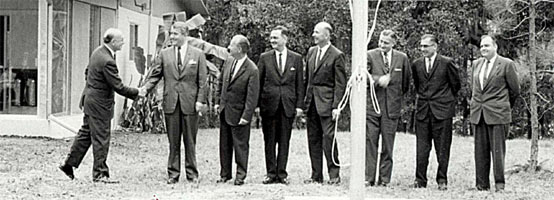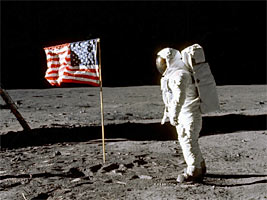|
Dr.
Wernher von Braun, the first director of NASA's Marshall Space
Flight Center in Huntsville, Ala., and his team of rocket
scientists masterminded the mammoth Saturn V rocket that
launched humans to the moon. Every booster rocket used in
America's lunar landing missions was static fired and flight
certified at what was then known as the Mississippi Test
Facility, now NASA's Stennis Space Center, which this year is
also celebrating its 40th anniversary. All first- and
second-stage rockets of the Saturn V tested at the center
flawlessly performed their missions.

Government
officials officially raise the American flag for the first
time at the Mississippi Test Operations, now Stennis Space
Center, in 1962. The historic Rouchon House stands in the
background. Pictured, from left, are: Bart Slattery, public
affairs officer; Dr. Wernher von Braun, director; Capt.
William Fortune, first site manager; Dr. George Constan,
manager, Michoud Assembly Facility; Dr. Oswald Lange, chief,
Saturn Program Office; Dr. Hermann Weidener, chief, Structures
and Mechanics Laboratory; Dr. Karl Heimburg, director, Test
Laboratory; and Dan Driscoll, Test
Laboratory.
Apollo 8
expedited the expedition to the moon. Scheduled to be the
first human Apollo launch by a Saturn V, Apollo 8 was
originally scheduled to test the manned Lunar Module in an
Earth orbit. Changing it to a translunar mission marked a
giant step in NASA's lunar landing drive.
Apollo 8
flew as scheduled on Dec. 21, 1968, carrying Frank Borman,
James A. Lovell Jr. and William A. Anders on 10 orbits around
the moon. The entire mission was conceived, planned and
trained for in six months. The success of Apollo 8 made a
lunar landing before the 1960s ended possible. This tight
schedule was predicated on the knowledge that the Soviet Union
was planning a cislunar flight in that same time period, and
it was imperative that the United States be in the lunar
vicinity before the Soviets.

Astronaut Edwin E. Aldrin, Jr., lunar module
pilot of the first lunar landing mission, poses for a
photograph beside the deployed United States flag during
Apollo 11 Extravehicular Activity (EVA) on the lunar
surface. The Lunar Module (LM) is on the left, and the
footprints of the astronauts are clearly visible in the
soil of the Moon. Astronaut Neil A. Armstrong,
commander, took this picture with a 70mm Hasselblad
lunar surface camera. While astronauts Armstrong and
Aldrin descended in the LM the "Eagle" to explore the
Sea of Tranquility region of the Moon, astronaut Michael
Collins, command module pilot, remained with the Command
and Service Modules (CSM) "Columbia" in
lunar-orbit. | On July 16, 1969,
Apollo 11 left Earth for a mission to land men on the moon. As
Apollo orbited the moon, the Lunar Module, known as the
"Eagle" by its two crewmembers, Armstrong and Edwin Aldrin,
separated nicely from the mother ship on the back side of the
moon. But when the Command Module cleared the moon and
communications resumed with Mission Control, communications
and telemetry between the MCC in Houston and Apollo were bad.
At this point Mission Control had about five minutes in which
to decide whether or not to abort the lunar landing. Then,
with the Lunar Module four minutes away from its landing, the
crew discovered that its altimeter and velocity gauges were in
error. Those problems were corrected. Next the crew reported a
computer alarm. A quick flight control analysis resulted in a
decision to continue. But as the Eagle prepared to set down,
Armstrong was forced to override the planned landing site to
avoid rocky and dangerous terrain. The Eagle did land with
less than 30 seconds of fuel remaining. For a time, due to
unanticipated irregularities of the lunar gravitational field,
NASA did not know precisely where.
For many
who worked at JSC in April 1970, the flight of Apollo 13 will
never be forgotten. Never before had the hostility of space
been so starkly evident and the threat of catastrophe so
imminent. |





